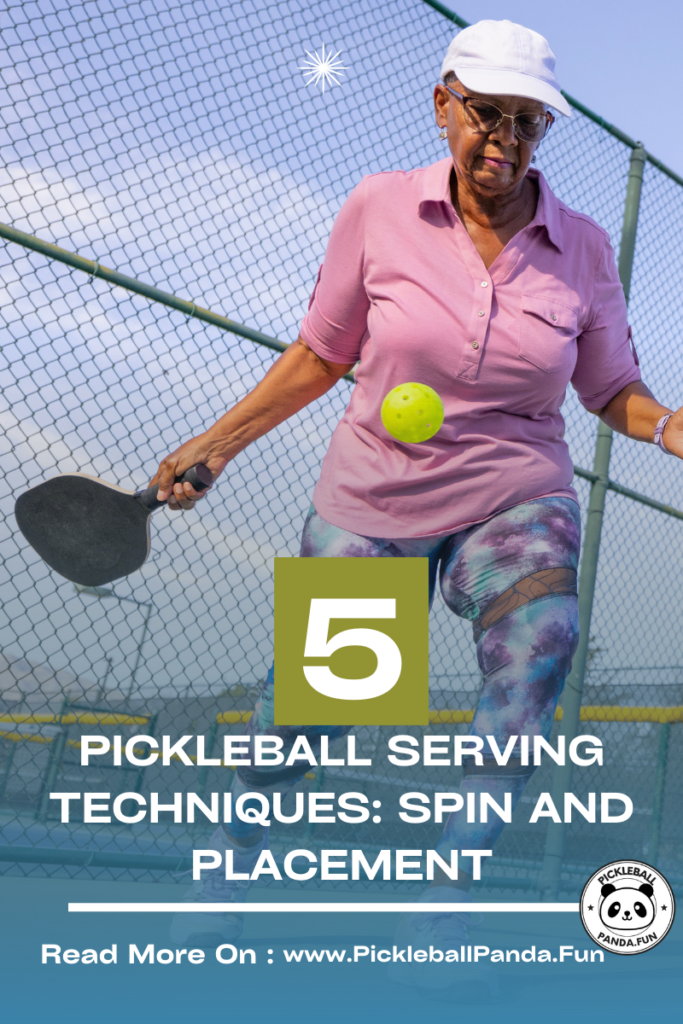
Pickleball Serving Techniques: Spin and Placement
Pickleball, a sport that has been gaining popularity at an astonishing rate, combines elements of tennis, badminton, and table tennis. It’s a game that’s easy to pick up but can be incredibly challenging to master, especially when it comes to serving. The serve is the starting point of every pickleball rally, and mastering different serving techniques, including spin and placement, can give you a significant advantage on the court. In this comprehensive guide, we will explore the art of pickleball serving, focusing on spin and placement, to help you elevate your game.
Table of Contents
- Introduction to Pickleball Serving
- The Importance of a Strong Serve
- Basic Pickleball Serve
- Grip and Stance
- The Toss
- The Contact Point
- Adding Spin to Your Serve
- Topspin Serve
- Backspin Serve
- Sidespin Serve
- Placement Strategies
- Serving to the Forehand
- Serving to the Backhand
- Serving to the Middle
- Advanced Serving Techniques
- The Power Serve
- The Soft Drop Serve
- Mind Games: Mixing Up Your Serves
- Reading Your Opponent
- Practice Makes Perfect
- Common Mistakes to Avoid
- Stay Relaxed and Confident
- Conclusion
Introduction to Pickleball Serving
The serve in pickleball is not just a formality; it sets the tone for the entire point. A well-executed serve can put your opponents on the defensive, giving you the upper hand from the very beginning. In this article, we will delve into the mechanics and strategies of pickleball serving, with a special focus on spin and placement techniques.
The Importance of a Strong Serve
Your serve is your first opportunity to dictate the pace of the game. A strong, well-placed serve can force your opponents into a defensive position and limit their options. It is the only time in the game you can control the ball 100%. To achieve this, you need to understand the fundamentals of serving.
Basic Pickleball Serve
Grip and Stance
Before we dive into spin and placement, it’s crucial to establish a solid foundation for your serve. Start with your grip and stance.
- Hold the paddle with a comfortable, relaxed grip, and start paddle head pointed down and below the waist.
- Stand with your feet shoulder-width apart, knees slightly bent, and your weight evenly distributed. Keep your hips rotated back towards the dominant hand you swinging with.
The Toss
The toss is where it all begins. A consistent toss is essential for a consistent serve.
- Practice tossing the ball to the same spot every time.
- The ideal toss height is around 12-18 inches above your intended contact point.
The Contact Point
When serving, make contact with the ball at waist height.
- Keep your eye on the ball and your paddle face perpendicular to the net.
- Follow through with your swing to add power and control.
Adding Spin to Your Serve
We recommend being consistent and hitting through the ball before adding spin. Spin is a game-changer in pickleball. It can make your serves unpredictable and challenging to return. Let’s explore three types of spin serves:
Topspin Serve
Most commonly used, always start with topspin. A topspin serve adds forward rotation to the ball, making it dip over the net and bounce aggressively. This will increase your margin for error from serving out as it dips downward as the ball slows down.
- Brush the ball from low to high with an open paddle face.
- Aim above the top of the net to clear it safely.
Backspin Serve
Backspin imparts backward rotation, causing the ball to stay low and slow down upon crossing the net.
- Slice underneath the ball from high to low.
- Aim for a shallow clearance over the net.
Sidespin Serve
Sidespin introduces lateral spin, making the ball curve to the left or right.
- Swipe the ball from left to right or right to left, depending on your desired direction.
- Confuse your opponents with unpredictable curves.
Placement Strategies
Adding spin to your serve is only half the battle. Knowing where to place the ball is equally important.
Serving to the Forehand
Targeting your opponent’s forehand can put them off balance, especially if they have a weaker forehand.
- Aim for the sideline, forcing them to stretch.
- Mix in spin for added complexity.
Serving to the Backhand
Attacking the backhand can exploit your opponent’s vulnerabilities.
- Direct your serve towards their backhand corner.
- Use spin to keep the ball low and challenging to handle.
Serving to the Middle
The middle of the court is a no-man’s land, and placing your serve there can create confusion.
- Aim between your opponent’s forehand and backhand.
- Add spin to keep them guessing.
Advanced Serving Techniques
As you progress, consider incorporating advanced serving techniques into your game.
The Power Serve
Unleash your inner force with a power serve that travels fast and deep.
- Generate more speed by using your entire body in the serve.
- Combine power with spin for a lethal combination.
The Soft Drop Serve
Sometimes, a gentle touch can be just as effective as power.
- Softly drop the ball over the net.
- Catch your opponent off guard with unexpected finesse.
Mind Games: Mixing Up Your Serves
Varying your serves is key to keeping your opponents guessing.
- Alternate between topspin, backspin, and sidespin.
- Change your placement to exploit weaknesses.
Reading Your Opponent
Pay attention to your opponent’s weaknesses and adjust your serves accordingly.
- Observe their movement and reactions.
- Exploit their vulnerabilities for strategic advantage.
Practice Makes Perfect
Consistent practice is the path to mastering your pickleball serves.
- Spend time on the court perfecting your technique.
- Experiment with different spins and placements.
Common Mistakes to Avoid
Be aware of common mistakes that can undermine your serves.
- Avoid excessive power without control.
- Don’t become predictable with your serves.
Stay Relaxed and Confident
Serving can be nerve-wracking, but confidence is key.
- Take deep breaths and stay relaxed.
- Believe in your abilities and execute with confidence.
- Take your time and bounce the ball with or without the paddle to get a rhythm and routine
Conclusion
In conclusion, mastering the art of serving in pickleball is a journey that requires dedication and practice. By understanding the mechanics of spin, the nuances of ball placement, and the psychology of your opponents, you can elevate your game to new heights. Remember, a strong serve is your ticket to gaining the upper hand in every match.
FAQs
1. How can I improve my toss for a better serve?
- Practice your toss regularly, focusing on consistency and height control.
2. Which spin serve is the most effective in pickleball?
- The effectiveness of spin serves depends on your opponent’s weaknesses and your ability to execute them. Experiment to find what works best for you.
3. Is it essential to have a powerful serve in pickleball?
- While power can be an asset, control and placement are equally important. A well-placed, controlled serve can be just as effective.
4. How can I practice my serve alone?
- You can practice your serve against a wall or use a ball machine designed for pickleball.
5. How can I improve my consistency in adding spin to my serves?
- Consistency comes with practice. Focus on your wrist action and paddle angle to control spin effectively.
Now that you’ve gained insights into pickleball serving techniques, take to the court with confidence and hone your skills. Remember that practice is the key to mastery, and by incorporating these strategies into your game, you’ll become a formidable opponent on the pickleball court.
Don’t miss out on improving your pickleball game! Access more valuable tips and resources by clicking the link below:
Access Now: www.PickleballPanda.Fun
So, gear up, practice your serves, and get ready to ace your next pickleball match with spin and precision!
